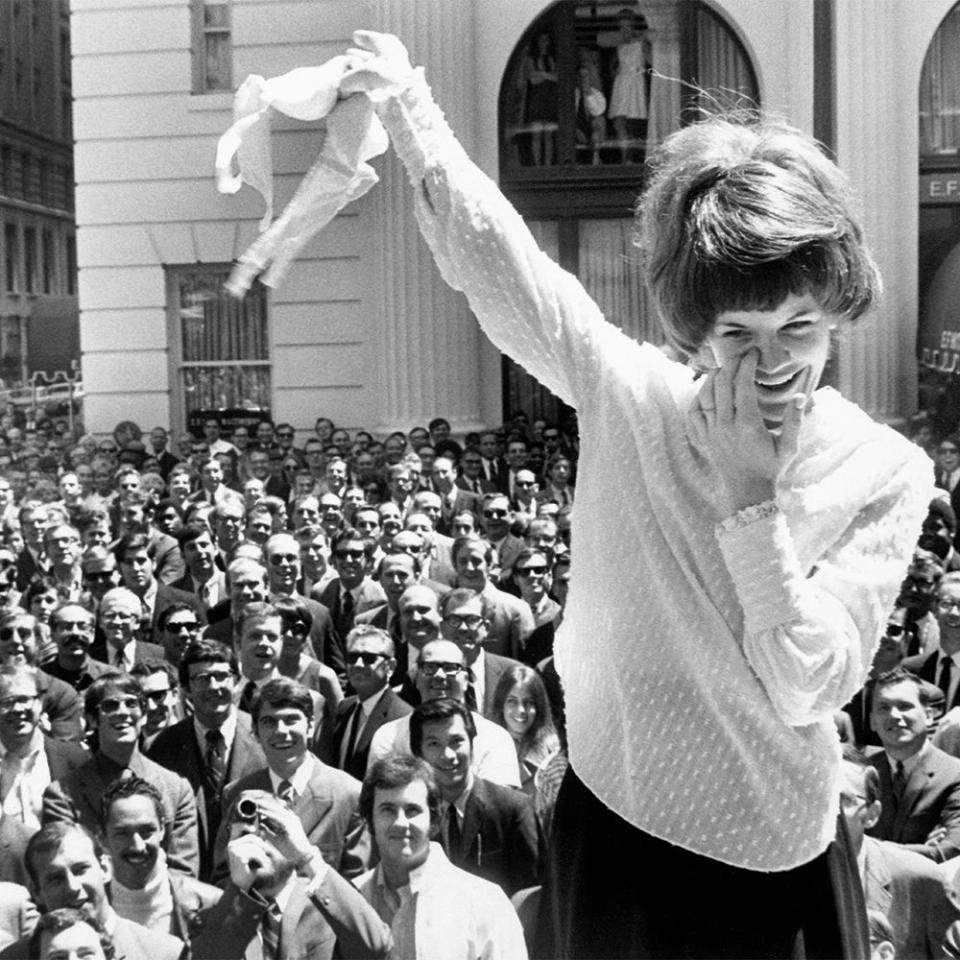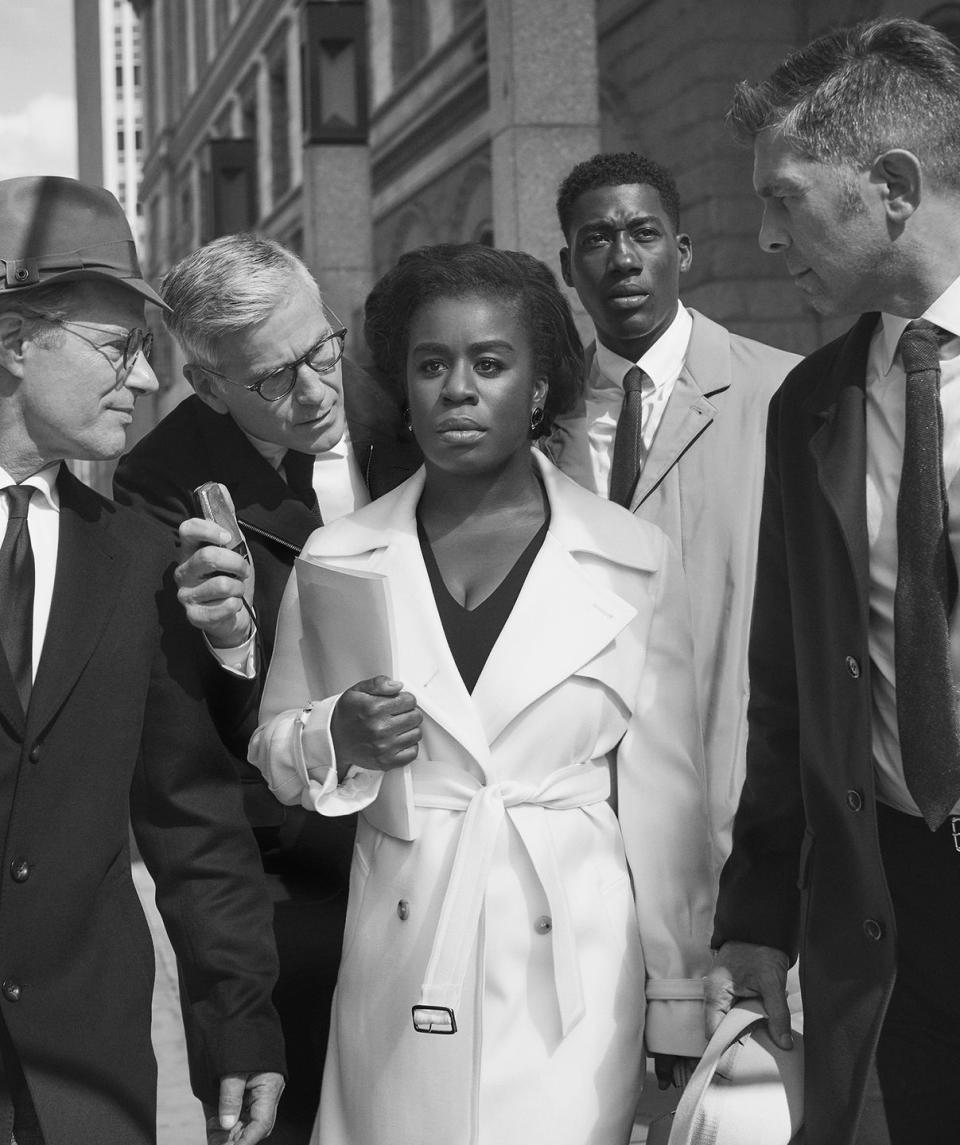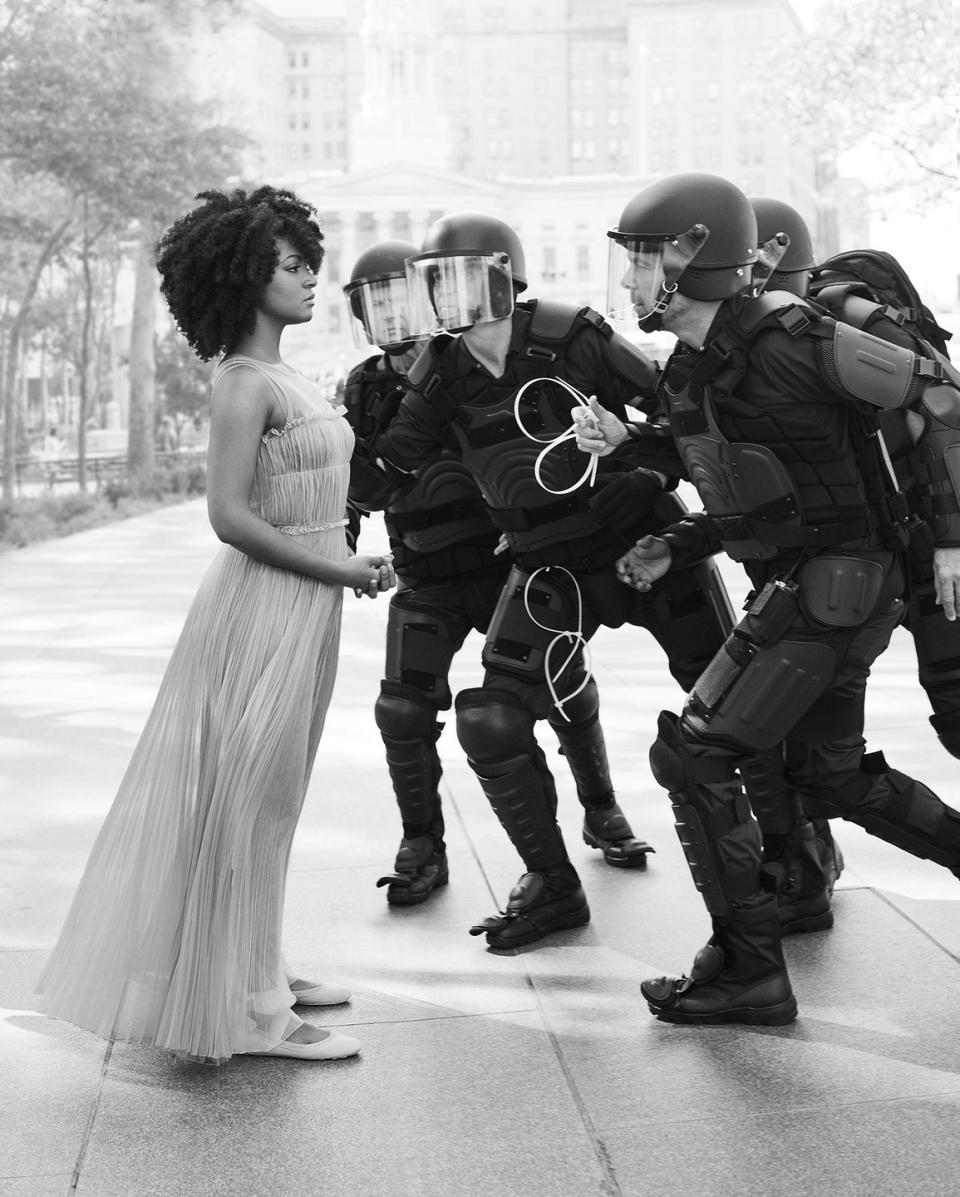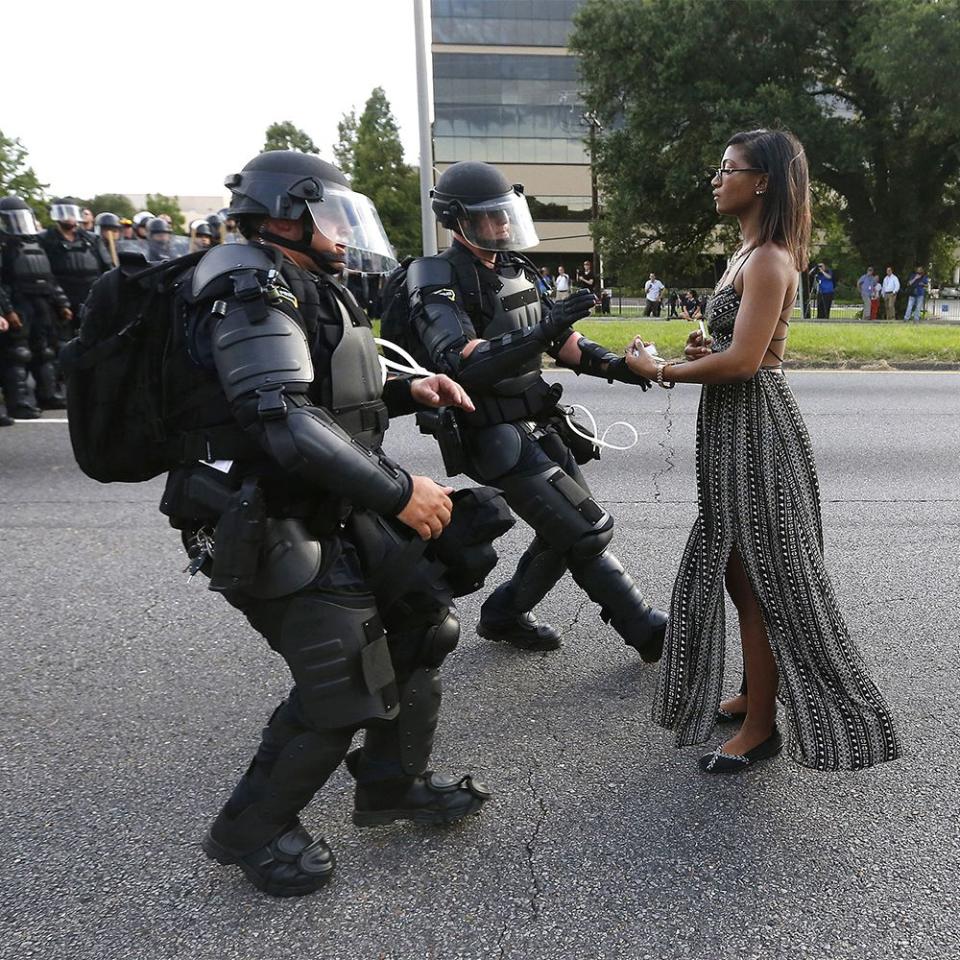Iconic Images of Social Change Prove How Far We Still Have to Go

"We must be willing to make others uncomfortable."
Roxane Gay reflects on the current resistance and its roots in the women’s liberation movement, as re-created here by Katie Holmes.
Politicians often call for civility and decorum in protest, as if challenging the status quo is supposed to be a well-mannered affair. Such people imagine that change requires politely asking those in power to cede the control they have wielded with impunity. Such is not the case. Now, as we approach the third year of the Trump presidency, it’s a useful time to think about feminist protest and women’s liberation, a movement that was complicated, messy, and unruly, but perhaps too well mannered.

In the 1960s and ’70s, women entered the workplace in unprecedented numbers while still managing their households. They were constrained by sexism in nearly every aspect of their lives. Something had to change. And so, in the wake of the civil rights movement, women’s liberation was born. These activists fought for many of the same things feminists today are still fighting for: reproductive freedom, equal pay, subsidized child care, and eradicating misogyny. The most prominent feature of women’s liberation was the idea of sisterhood, that women throughout the world were intrinsically connected by virtue of their womanhood. The movement’s structure tried to reflect this sisterhood. Power could be shared. Many voices could contribute to change. And some change was indeed accomplished: At the National Women’s Conference, in 1977, thousands of women gathered in Houston to formalize a plan for realizing women’s liberation to be presented to the White House and Congress. By the end of the conference, a National Plan of Action had been created, featuring 26 planks covering sexual and domestic violence, disability, reproductive freedom, and other issues. Women were part of a national conversation that they’d had a direct hand in shaping.

But that conversation did not create much structural change. Sisterhood was a nice idea, but as inclusive as the movement tried to be, it was dominated by middle- and upper-class women. Mainstream women’s liberation did not seek to reimagine the world and its capitalist underpinnings. If it had, the feminist agenda might have expanded beyond the basic human rights we are still fighting for. If it had, we might have already elected the first woman president of the United States, and the second or third.
After Donald Trump became president, women came together once more, with the Women’s March on Washington, on January 21, 2017. After a few missteps, the organizers formed a national leadership team, coordinated hundreds of sister marches around the world, and developed “unity principles” to codify what and who the movement stood for. The influence of women’s liberation was readily apparent. They marched to make clear that women would not be silent. Like the women’s liberation movement before it, this march and many of the feminist actions since-commonly called acts of resistance-have centered women in a national conversation.
The other unfortunate common ground is that this resistance has been mostly well mannered, and we haven’t seen a great deal of structural change. But we are not necessarily fated to continue this pattern: History repeats itself until people decide not to let it. Change requires more than resistance. It requires more than marching or compromise or civility. We must be willing to be uncomfortable and to make others uncomfortable, whether through uncivil protest, comprehensive boycotts, or a bold reimagining of what the world could look like if liberated from the patriarchy. We are well past the time for resistance. Now we must revolt, by any means necessary.
"What kept me calm that night and in the days ahead was the armor I wore."
Charlayne Hunter-Gault looks back on her experiences in the early days of the civil rights movement, as represented by Uzo Aduba.
When I was a senior in high school, in 1959, I had started looking for schools that would offer a way for me to fulfill my dream of becoming a journalist-a dream I had nurtured since I was about five years old, reading about Brenda Starr, the dashing redheaded comic-strip character who traveled the world in search of stories to report. When I told my mother I wanted to be like Brenda Starr, she didn’t tell me that was an impossible dream for a little black girl in the segregated South. She just said in her usual soft-spoken way: “If that’s what you want to do.”
Those simple words led me years later to successfully challenge the decades-long system of segregation and its lie of separate but equal when my classmate Hamilton Holmes and I successfully sued to gain admittance to Georgia’s 175-year-old, all-white state university.

That first day, as I walked onto the campus, I was greeted by crowds shouting ugly racist taunts and screams of “Go home!” But in my mind’s eye, I was remembering being crowned queen at my elementary school when my family raised the most money in the yearly contest held to help address the country’s separate-and- unequal school funding and its consequences-among them the hand-me-down textbooks we inherited from white schools, often with pages missing. From that day on, even though the teasing of my classmates made me eventually take off my tiara, the notion that I was a queen had taken the place of the tiara. So when I heard the mob using the N-word at the University of Georgia, I knew they couldn’t be talking about me, for I was, after all, a queen! Likewise, my invisible tiara was on my head during the riot outside my dormitory a few nights later, when a demonstrator threw a brick through my window. What kept me calm that night and in the days ahead was the armor I wore, the history I had been taught at home, school, and church, going back to the defiance of our unjustly enslaved ancestors. On that night, one of the psalms my grandmother had insisted I learn came back to me: “Yea, though I walk through the valley of the shadow of death, I will fear no evil.”
My focus was not so much on the history we were making but on making it from one day to the next. Once when I was sitting in my room on the first floor (all the other student rooms were on the second), as I looked in the mirror, I smiled and said, “Hello,” aloud to myself-for I had just realized that I had not uttered a human sound that entire day as I went to classes. Thankfully I had been an only child for eight years and was comfortable in my skin. I also loved to read, so I had plenty of quiet time to study.

On weekends I drove the 73 miles to Atlanta to report for The Atlanta Inquirer, an upstart newspaper that covered the burgeoning Atlanta Student Movement and its direct-action protests against the stores in Atlanta where black people could spend their money but were not allowed to eat in the dining facilities. “Our time has come!” was their slogan, as well as for the growing student movement elsewhere that ultimately ended all segregation throughout the South. After graduating in 1963, I was hired by The New Yorker and, in time, was promoted to “The Talk of the Town” section as its first black reporter. And I brought my history to bear as I wrote about black people in ways that defied their usual descriptions-either as examples of existential misery or as the recipients of some rare achievement for a black person.
Today when I speak to young people the world over-from South Africa to my most recent trip to Denmark-I recount those days that are still vivid in my memory but which, for the most part, are not being taught in our schools. And I do that because I want them to know the power that lies within them-the invisible armor they wear that will protect them as they face their own inevitable challenges. From what I’ve seen so far, they are, in their own way, declaring, “Our time has come.” They should know that their way won’t always be easy and might actually even be dangerous. But they should also know that they are fitted with the armor of a proud history- an American history-that will protect them. As they continue to pick up the baton, they too will overcome any and every obstacle that threatens our democratic promise. And I am optimistic they will be the giants on whose shoulders generations after them will stand.
"We need white women to call to their sisters and be the influence they need."
Ieshia Evans reenacts her inspiring moment of resistance at a Black Lives Matter protest in Baton Rouge-and Tamika D. Mallory looks into the future of social change.
The death of Trayvon Martin in 2012 happened at the same time when my son entered his teenage years. President Obama acknowledged the grim familiarity of this tragedy to black families everywhere, saying, “If I had a son, he’d look like Trayvon.” For me, the timing was such that I had a rising fear for my son’s life every time he asked to exercise his growing freedom. While I was his role model, engaged in organizing and activism for his right to be safe in society, I was simultaneously stripping him of his manhood every time he left the house: “Don’t talk back. Don’t look them in the eye. Be sure to say, ‘Yes, sir,’ and ‘No, sir,’ even if you’re in the right.” Other mothers do not have to have those uncomfortable conversations with their sons.

The American feminist movement has historically ignored or excluded black and brown women. During the suffragist movement, organizers of the Women’s Suffrage Parade asked Ida B. Wells to march at the back of the line. In the 1970s, the Combahee River Collective formed to articulate the issues facing black women that were being largely ignored by the white feminists of the time. But black and brown women have always done what we needed to do in order to make our voices heard. It was black women who founded Black Lives Matter, after all. And it’s no coincidence that the most powerful images to come out of the 21st-century fight for racial justice-like the image of Ieshia Evans, re-created here by Ieshia herself, at a protest against the 2016 police slaying of Alton Sterling in Baton Rouge-feature women speaking truth to power. Believe me, if we could defeat white supremacy all on our own, we would have done it already. Today mainstream feminism is at a crossroads. At a time when women are being activated in record numbers, we have the opportunity to reframe the conversation about women’s rights so that it centers all of our concerns-not just those that apply to white women. It’s true we need to win elections, but we also need to be real about the greater cultural battle we’re in. We are fighting for every woman to understand that an injustice to one is an injustice to all. And that means white women need to show up-at the polls and on the streets-for the issues affecting people who don’t look like them.
When women come together to protect the rights of the most marginalized, we are powerful. I was proud to see women of all races occupying a U.S. Senate office building last summer, where some 600 people were arrested in protest of the cruel policy of separating immigrant parents and children. It was inspiring to see women from across the nation marching on the Capitol and on the steps of the Supreme Court to protest Brett Kavanaugh’s confirmation. That is the beauty of women organizing for other women: At some point, all of our issues cross and connect in that they impact all women.

Yet, still I have wondered where the outrage is when injustices happen to black women-when, for example, Crystal Mason in Texas was sentenced to five years in prison simply for voting. Or when Chikesia Clemons was arrested after being assaulted by police inside an Alabama Waffle House. It’s time for white women to take stock of whom in their lives they are and aren’t reaching. The 2016 election was a wake-up call, with the majority of white women either voting for Trump or not at all. Since then, a record number of women are running for office, but it’s difficult to say what the impact has been in the greater cultural war. During the recent controversy surrounding Kavanaugh’s nomination, a Quinnipiac poll found that white women were almost evenly split, with 43 percent reporting that they “tended to believe” Kavanaugh’s claims of innocence versus 46 percent who believed Christine Blasey Ford. In order for us all to move forward, we need white women to call to their sisters and be the influence they need.
So often we avoid talking about politics because it’s uncomfortable. We act like it doesn’t matter, and we can go along to get along. But this is precisely the attitude that has gotten us into such dangerous times and given rise to voting patterns that reflect a deep lack of empathy for people of color, women, poor people, immigrants, and so many vulnerable communities. White women, your courage is needed now-whether that means sitting down with your family, speaking up at your place of worship, or canvassing your neighborhood. If we can commit to looking out for all vulnerable people, not just those who remind us of ourselves, there may be hope for us yet.
This article originally appears in the December '18/January '19 issue of Harper's BAZAAR, available on newsstands now.
Fashion Credits: Katie Holmes: Stella McCartney sweater and pants; Her own jewelry; Stella McCartney Lingerie bra; Uzo Aduba: Max Mara trench coat and dress; Stylist’s own earrings; Ieshia Evans: Dior dress and shoes; Hair (Holmes): DJ Quintero; Hair (Aduba and Evans): Takisha Sturdivant-Drew for TSD Hair; Makeup (Holmes): Genevieve for Lancôme; Makeup (Aduba and Evans): Janice Kinjo for Dior Backstage; Manicures: Mar y Soul for Dior Beauty; Grooming: Linh Nguyen for Amika; Production: Jennifer Segerholt for Resin Projects; Prop Styling: Dominique Baynes; Location Scout: Misha Jenkins.
('You Might Also Like',)

